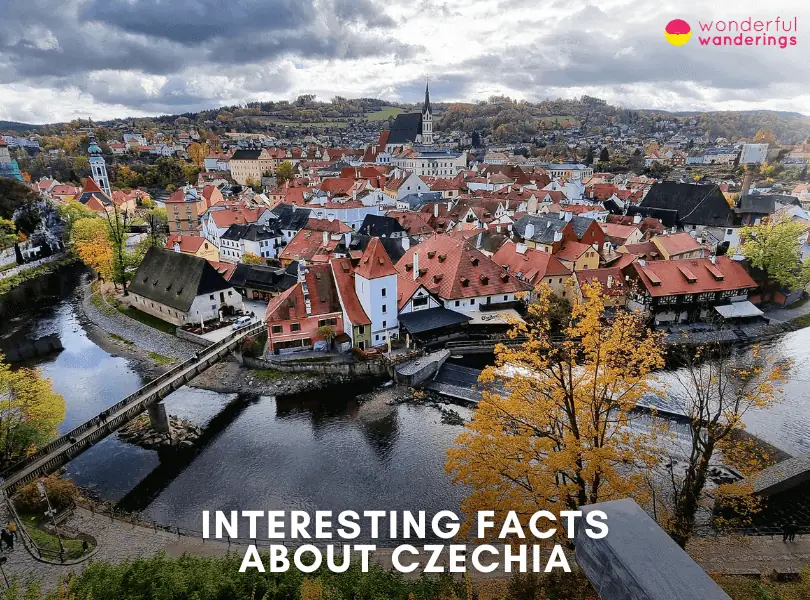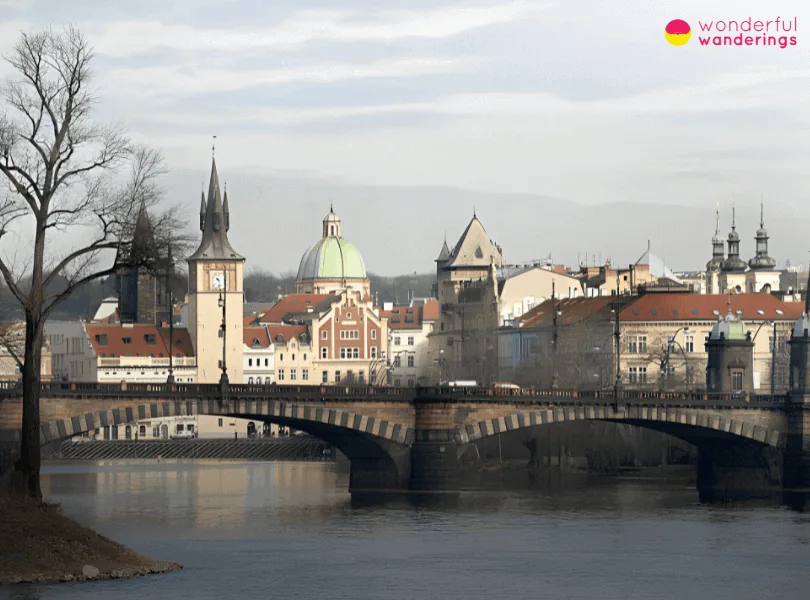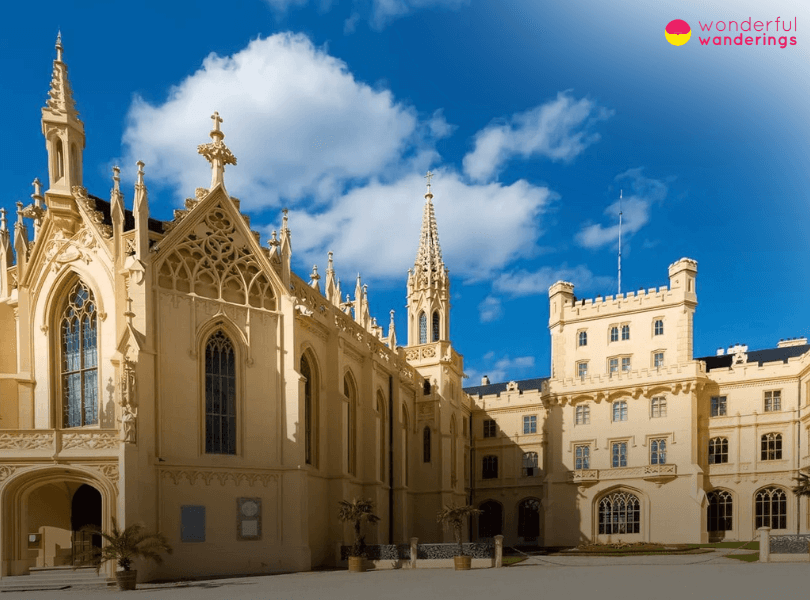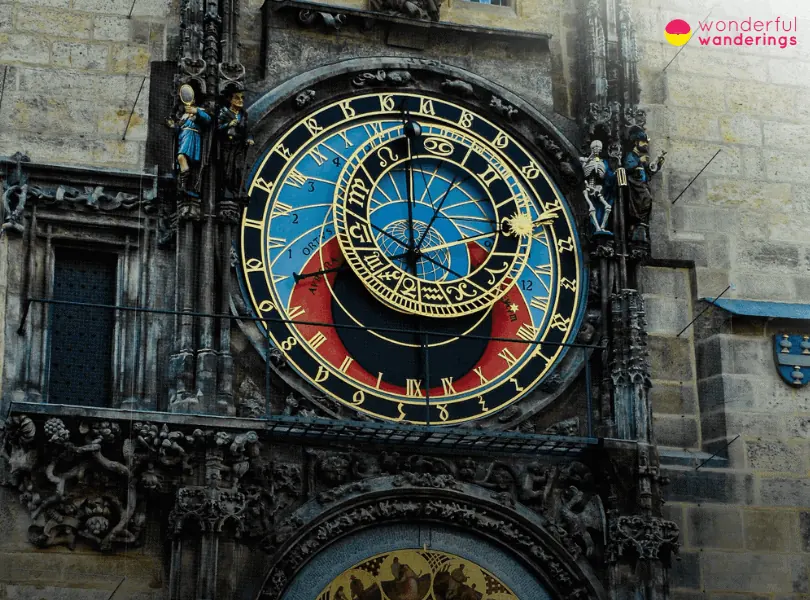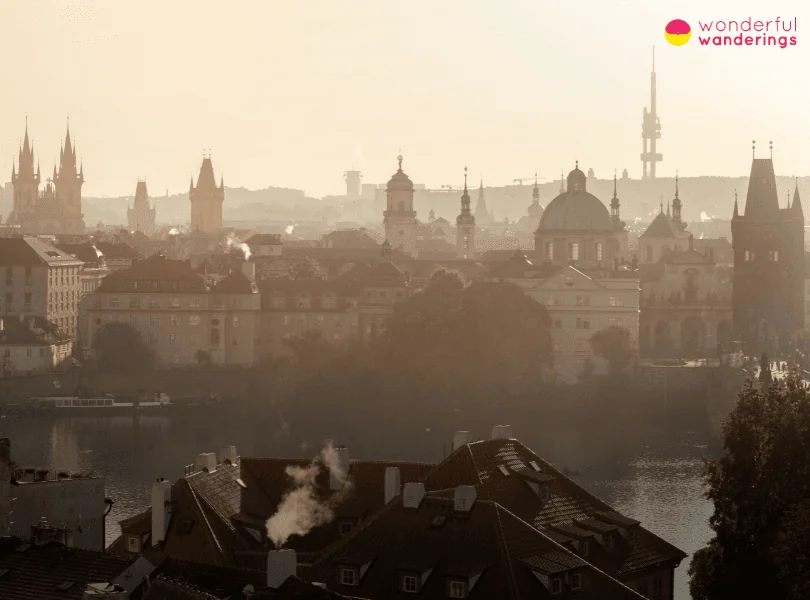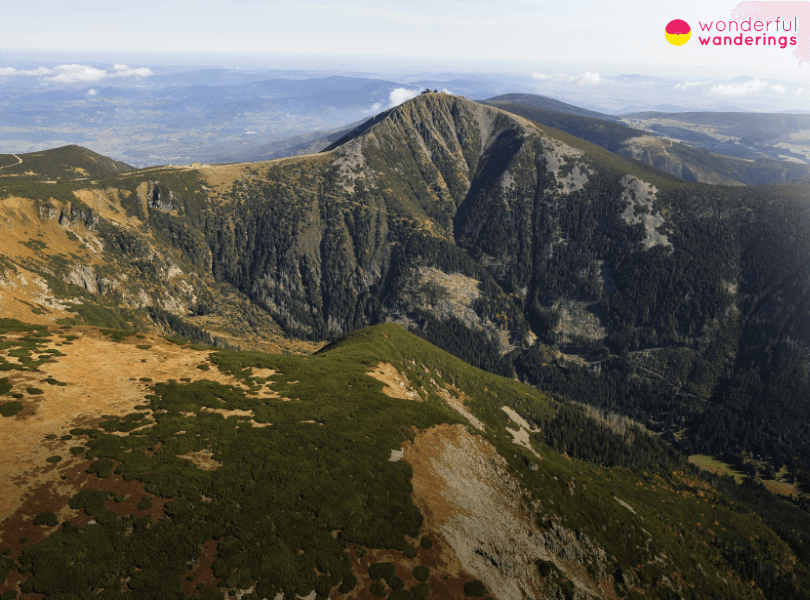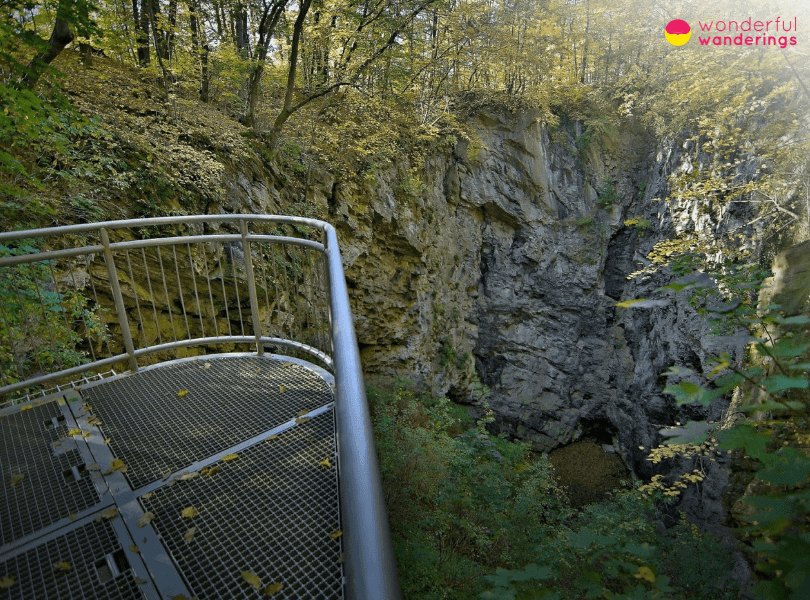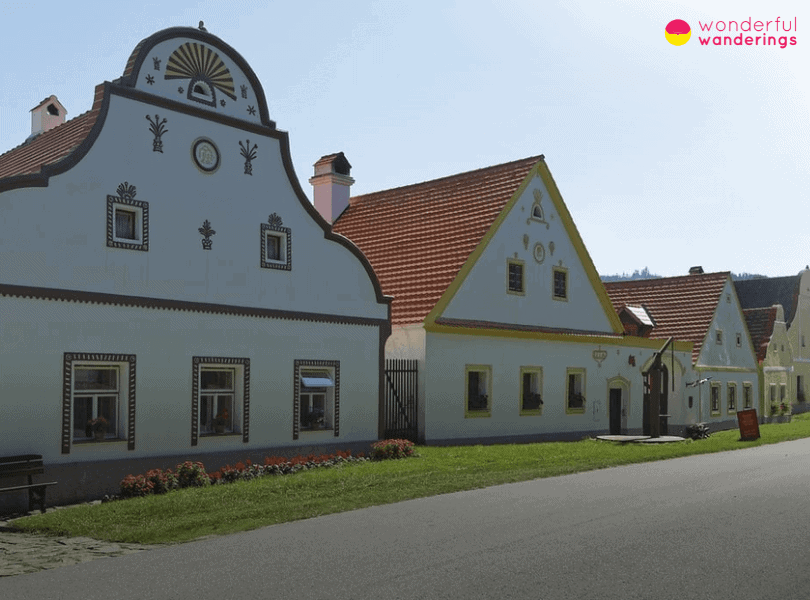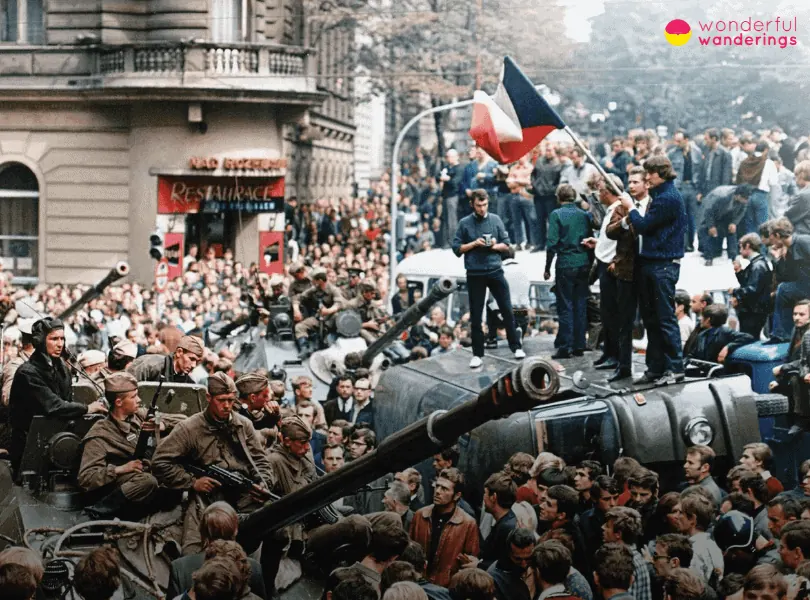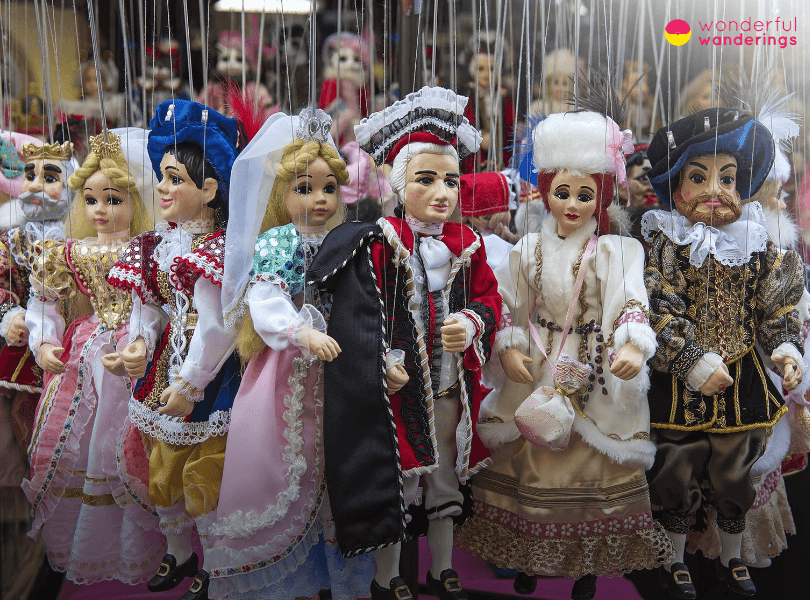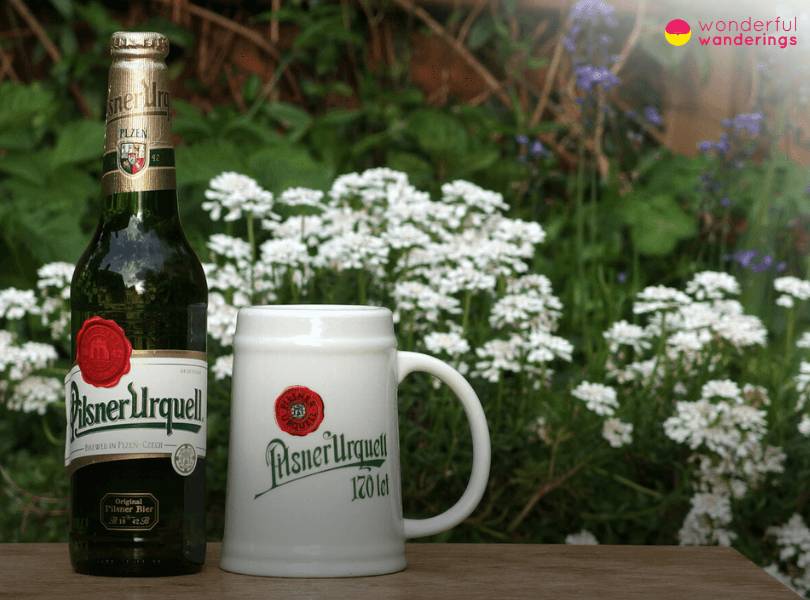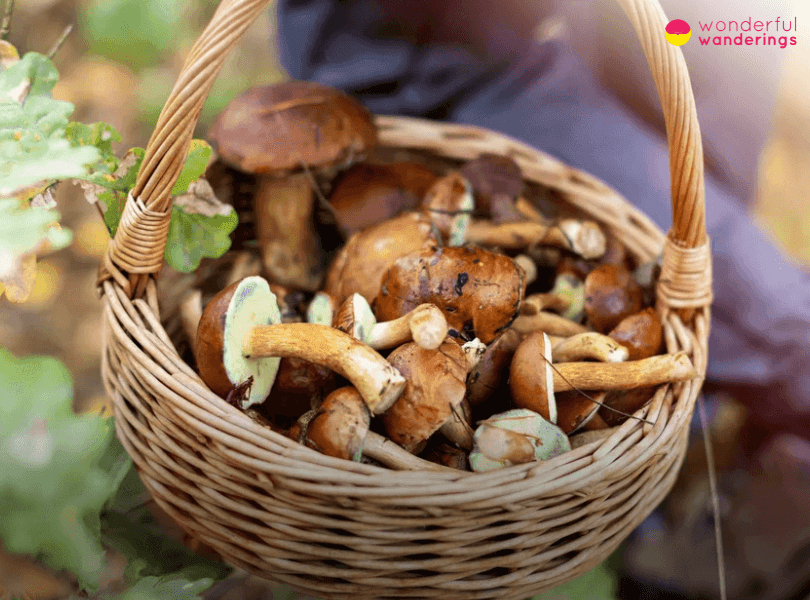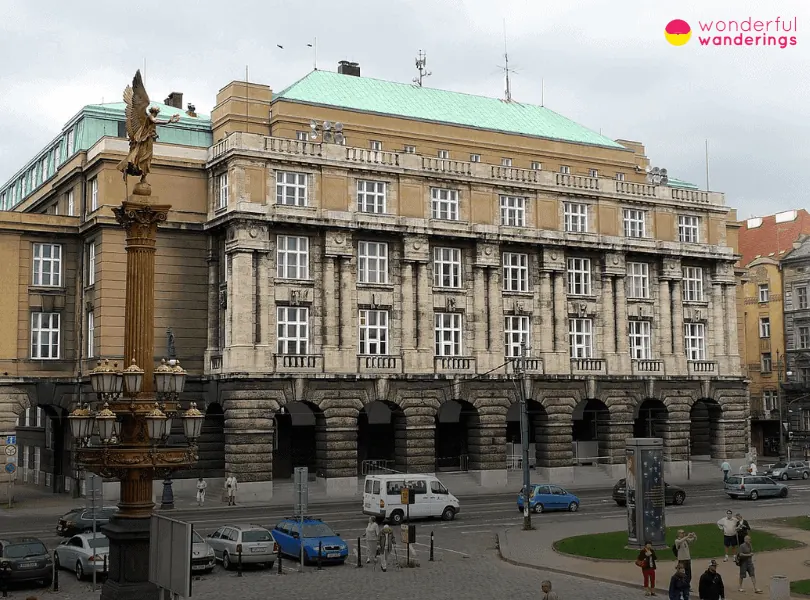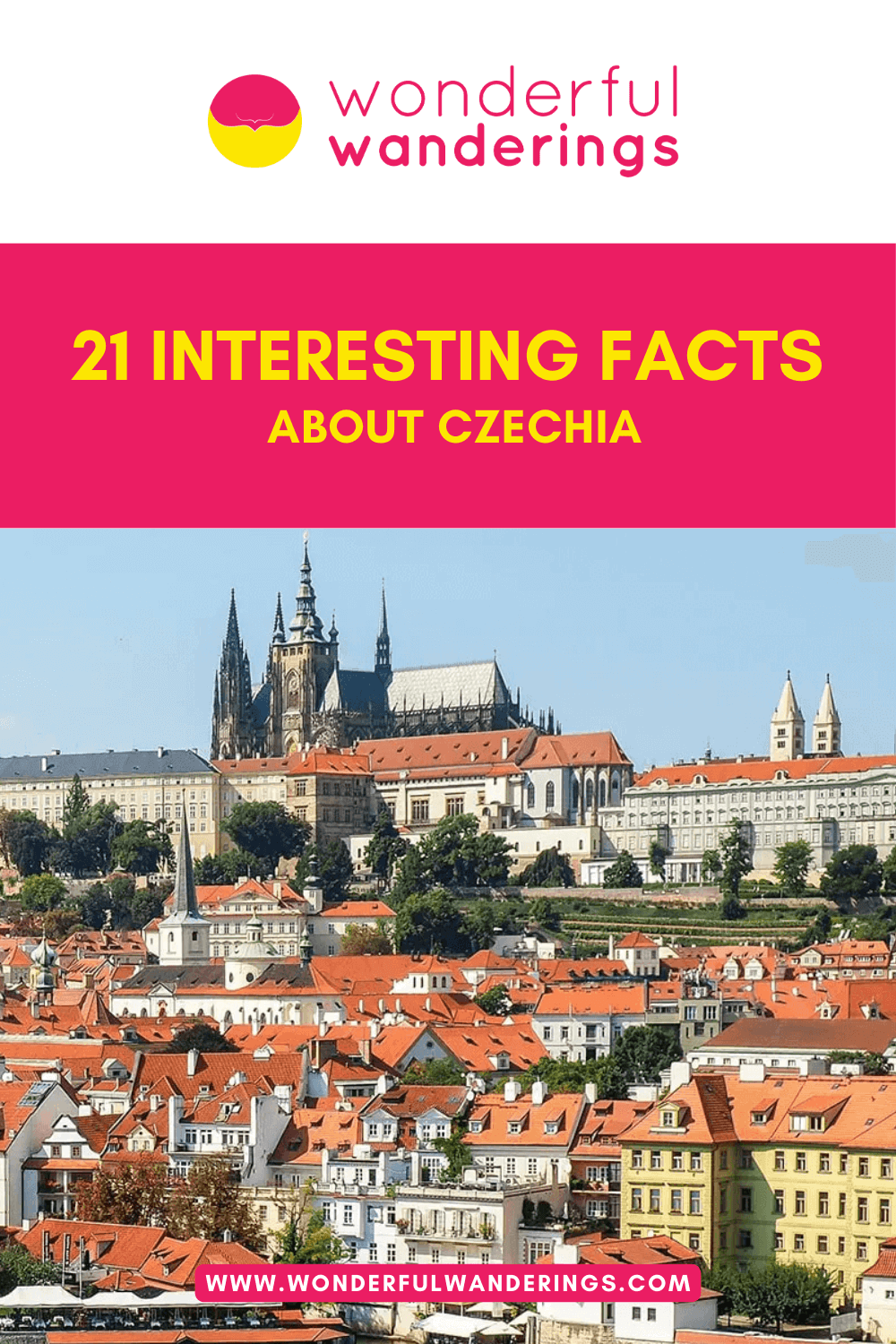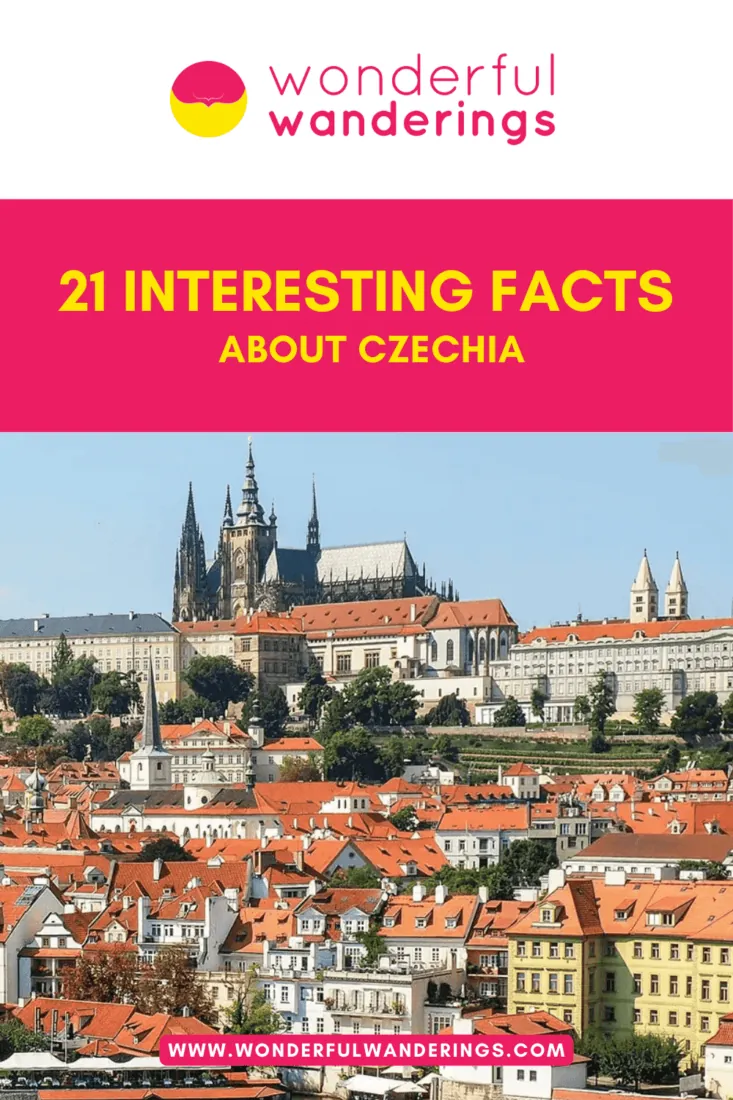Czechia is a country with a rich cultural heritage and storied history. The capital city of Prague features a remarkably well-preserved medieval core, exemplified by architectural landmarks like the 9th-century Prague Castle, the Charles Bridge from the 14th century and Old Town Square, showcasing a diverse mix of Gothic, Baroque and Renaissance buildings. Prague offers an array of world-class museums, theaters, galleries, cafés and other sites that highlight its role as a flourishing cultural capital. Czechia is renowned for having the highest density of castles in the world, with over 2,000 castles, chateaus and ruins spread across the country. The country’s varied natural landscapes provide plenty of opportunities for outdoor recreation, from hiking in mountain ranges of Czechia, like the Krkonoše, to canoeing on rivers winding through Bohemian Switzerland National Park. The nation also prides on its storied beer heritage, traced back to the original Pilsner beer first brewed in Plzeň in 1842. Czechia provides visitors with experiences, including its rich historic architecture, natural diversity, storied beer culture and dynamic urban energy.
Listed below are interesting facts about Czechia.
- Czechia Is the 7th Safest Country Globally. Czechia ranks 7th in the 2024 Global Peace Index, which measures 163 countries on domestic and international conflict, societal safety and security and militarization. Czechia scores highly on indicators like violent demonstrations, crime, weapons access and political instability. Crime rates are low, with few homicides and petty offenses annually. Public services like healthcare and education are well-developed. Income inequality is lower than in other European countries. Discrimination based on gender, religion or sexual orientation is uncommon. These factors contribute to Czechia’s high safety and societal harmony.
- Prague Is Europe’s Largest Expat Community. Prague has over 200,000 foreign residents, making it Europe’s largest expat community. The city’s affordable cost of living, safety, history and culture attract expats looking to relocate. Housing and amenities in Prague cost a fraction of other European capitals but maintain high quality. Goods, services and public transit are affordable, enabling a comfortable Western lifestyle. Prague is considered one of Europe’s safest major cities, with extremely low violent crime and terrorism. Prague’s central European location also makes weekend trips around the continent convenient and inexpensive. The city provides an ideal home base for exploring Europe.
- 2,000+ Castles and Chateaux in Czechia. Czechia has the world’s highest per capita density of castles, with over 2,000 castles, chateaux and ruins. The castles display diverse Romanesque, Gothic, Baroque, Renaissance and neo-Gothic architectural styles. Some were residences and power centers, while others had military purposes. Many are exceptionally well-preserved, maintained, reconstructed or repurposed over time rather than left as ruins. Castles were reconstructed to suit contemporary architectural tastes and needs, resulting in many renovations, extensions and style mixtures.
- Prague’s Old Town has the 3rd Oldest Astronomical Clock. The 1410 astronomical clock in Prague’s Old Town Hall is the world’s third-oldest astronomical clock still operating today after Padua (1354) and Lund (1386). The artistic clock combines astronomical and calendar dials with moving sculptures like Apostle figures and a skeleton symbolizing Death striking the time. Despite damage over its 600+ year history, the original 1410 astrolabe mechanism and some later components like the 1490 calendar dial still function. The same family has maintained the clock for over 150 years, winding it daily.
- Beer Is Cheaper Than Water in Czechia. In many Czech pubs and restaurants, a half-liter of draft beer costs only €0.91 ($1, £0.79), while bottled water costs over €2 ($3, £2). Factors enabling Czechia’s cheap beer include a strong beer culture, tax incentives for breweries, localized production and distribution and an overall lower cost of living. Czechs drink over 160 liters of beer per capita annually and retailers can profit from lower prices and high demand. Visitors to Czechia are recommended to order beer with meals rather than paying more for water.
Contents
- 1. Czechia Is the 7th Safest Country Globally
- 2. Prague Is Europe’s Largest Expat Community
- 3. 2,000+ Castles and Chateaux in Czechia
- 4. Prague’s Old Town Has the 3rd Oldest Astronomical Clock
- 5. Beer Is Cheaper Than Water in Czechia
- 6. Prague Is the “City of a Hundred Spires”
- 7. Mount Sněžka Is the Highest Peak in Czechia
- 8. Czechia Inventions. Soft Contacts, Lightning Rods, Polarography, Sugar Cubes
- 9. Czechia Was the 3rd Nation in Space
- 10. 250,000+ Words Czech language
- 11. The Deepest Sinkhole in Central Europe at 473+ Meters
- 12. Czechia Video Game Industry – Mafia, Kingdom Come, Beat Saber
- 13. 12 Czech Sites on the UNESCO World Heritage List
- 14. The Czech Crown Is Czechia’s Official Currency
- 15. Ice Hockey Is the Most Popular Sport in Czechia
- 16. 1989 Velvet Revolution Ended Communist Rule in Czechia
- 17. Puppetry Tradition in Czechia Since the Middle Ages
- 18. Pilsner Beer Was First Brewed in Plzeň
- 19. Semtex Plastic Explosives Were Invented in Czechia in 1966
- 20. Picking Mushrooms Is One of the Most Popular Czech Traditions
- 21. Oldest University in Central Europe Is in Prague
- How did Czechia get its name?
- Why should you visit Czechia?
1. Czechia Is the 7th Safest Country Globally
Czechia is ranked as the 7th safest country in the world according to the Global Peace Index 2024. This annual report analyzes 163 countries and territories based on 23 indicators covering ongoing domestic and international conflict, societal safety and security and militarization.
Specifically, Czechia scores very well on indicators related to violent demonstrations, violent crime, weapons access and political instability. The country has a stable political climate with little civil unrest. Crime rates are relatively low, with few homicides and petty crimes reported each year. Access to weapons is tightly controlled. Terrorist attacks or violent demonstrations are extremely rare in Czechia. Czechia has well-developed public services including healthcare and education. Income inequality is lower compared to other European nations. Discrimination based on gender, religion or sexual orientation is uncommon. These factors all contribute to the country’s high safety and societal harmony.
2. Prague Is Europe’s Largest Expat Community
Prague, the capital and largest city of Czechia, is home to Europe’s biggest community of expats, with over 200,000 foreign residents. The city’s low cost of living, safety, rich history and culture have made it an increasingly popular destination for expats looking to relocate abroad. Prague offers high-quality housing and amenities at a fraction of the cost of other European capitals. Goods and services from dining out to public transportation are very affordable. This allows expats to enjoy a comfortable, Western standard of living. Prague is considered one of Europe’s safest major cities. Violent crime rates are extremely low and terrorist attacks are almost unheard of. This sense of security appeals to many expats, especially those with families. The city’s central location makes weekend trips around Europe convenient and inexpensive. Prague provides an ideal home base to explore the rest of the continent.
3. 2,000+ Castles and Chateaux in Czechia
Czechia is known as the “land of castles” with over 2,000 castles, chateaux and castle ruins spread across the country. This gives Czechia the highest density of castles per capita in the world. The castles and chateaux showcase a variety of architectural styles from Romanesque and Gothic to Baroque, Renaissance and neo-Gothic. They range from small rural fortresses to sprawling palace complexes like the Prague Castle. Some served as residences and centers of power while others had a military purpose.
Many Czech castles and chateaux are exceptionally well-preserved as they have been maintained, reconstructed or repurposed over the centuries instead of being left to ruin. Most operate as museums, hotels or event venues. Visitors can take tours of the historical interiors, stroll the manicured gardens, dine at castle restaurants and participate in medieval festivals. The abundance of castles is partly due to the terrain and turbulent history. Nobles and royals built fortresses in strategic hilltop locations with a good vantage point and natural defenses. As property changed hands, new owners would reconstruct the castles to suit contemporary architectural tastes and needs, resulting in many renovations, extensions and style mixtures.
4. Prague’s Old Town Has the 3rd Oldest Astronomical Clock
The astronomical clock mounted on the southern wall of Prague’s Old Town Hall dates back to 1410 when it was created by clockmaker Mikuláš of Kadaň and professor of astronomy Jan Sindel. This makes it the third-oldest astronomical clock in the world after the 1354 clock in Padua, Italy and the 1386 clock in Lund, Sweden. It is also the oldest astronomical clock still in operation today. The Prague clock combines a mechanical astrolabe-style astronomical dial showing the positions of the sun, moon and stars with an artistic calendar dial and moving sculptures including figures of the Apostles and a skeleton representing Death striking the time. The clock has undergone numerous repairs and renovations over its 600+ year history after damage from wars, fires and simple wear and tear. It was nearly destroyed in 1945 when the Nazis bombed the Old Town Hall. The clock’s original 1410 astrolabe mechanism still functions today, along with some components added later like the 1490 calendar dial. Winding the clock has been the responsibility of the same family for over 150 years.
5. Beer Is Cheaper Than Water in Czechia
The Czechia is well-known for having some of the cheapest beer prices in the world, largely thanks to its long brewing history and high per capita consumption rates. At many local pubs and restaurants across the country, a half-liter mug of draft beer costs only €0.91 ($1, £0.79) while a bottle of water at the same establishments generally costs more, ranging from €2 ($3, £2). This phenomenon of cheaper beer prices is aided by favorable factors within the country. There is a strong cultural appreciation for beer, with the average Czech drinking over 160 liters yearly. There are tax incentives for Czech breweries and lower distribution costs for localized production and high demand. The country’s overall lower cost of living also allows retailers to charge less while still making profits. Visitors to the Czechia are recommended to order a refreshing mug of pilsner or lager to accompany a meal rather than paying more for bottled water.
6. Prague Is the “City of a Hundred Spires”
The historic city center of Prague, the capital of Czechia, is famously called the “City of a Hundred Spires” due to the skyline dotted with towers, turrets, steeples and ornate roof peaks. The Prague cityscape showcases architectural styles spanning over a thousand years, from Romanesque and Gothic to Baroque, Renaissance and Art Nouveau. Many spires belong to the city’s churches, cathedrals, synagogues, town halls and palace complexes, rising high above the red-roofed buildings. The centerpiece is the iconic Gothic spires of St. Vitus Cathedral within the Prague Castle complex, along with the twin Gothic steeples of the Church of Our Lady before Týn. Prague owes this spire-filled skyline to its unique preservation of medieval architecture. The city center survived wars and regimes that could have otherwise modernized or damaged it. Prague’s historical structures have been maintained, reconstructed and repurposed instead of demolished. This allowed layer upon layer of spires to remain standing or be rebuilt. The effect earned Prague UNESCO World Heritage status.
7. Mount Sněžka Is the Highest Peak in Czechia
Mount Sněžka is on the border between Poland and Czechia in the Krkonoše Mountains and stands at an elevation of 1,603 meters (0.99 miles), making it the highest natural summit in the Czechia. Its altitude, isolation and extreme weather contribute to its prestige and popularity. Sněžka offers alpine scenery and panoramic views over the surrounding Giant Mountains. The mountain environment supports rare high-altitude flora like the alpine poppy and fauna like the chamois antelope. Several hiking trails are leading to the summit of varying difficulty. The most direct route is a steep 2.5 kilometers (1.5 miles) climb from the Czech town of Pec pod Sněžkou. Visitors can also take a cable car up the Polish side of the mountain. Facilities available on the summit include a Czech post office, which has been selling commemorative stamps since 1945 and a Polish weather observatory built in 1976, which operates year-round even in extreme conditions. There are also the ruins of historic buildings like the Bohemian hut from 1825, a shelter for early mountaineers.
8. Czechia Inventions. Soft Contacts, Lightning Rods, Polarography, Sugar Cubes
Czechia has a long history of innovation in science, technology and industry. This small Central European country has punched above its weight in terms of impactful inventions. For example, Czech priest Prokop Diviš constructed one of the first functional lightning rods between 1750-1754, predating Benjamin Franklin. Czech chemist Jaroslav Heyrovský invented polarography in 1922 – a widely-used electroanalytical technique. The sugar cube was developed in Dačice, Czechia, by Jakub Kryštof Rad in 1843.
One of the most famous Czech inventions is the soft contact lens, created by chemist Otto Wichterle in 1961. Wichterle pioneered soft hydrogel lenses that could be comfortably worn for long periods using homemade equipment. This revolutionized visual correction around the world. Over 45 million people globally now use soft contact lenses. These examples demonstrate Czechia’s rich history of scientific and technical ingenuity. Czech inventors and researchers have made discoveries with an enormous international impact across disciplines like chemistry, physics, manufacturing and medicine. The lightning rod, polarography technique, sugar cube and soft contacts attest to Czechia’s impressive innovation legacy.
9. Czechia Was the 3rd Nation in Space
The Soviet Union launched the Soyuz 28 mission to the Salyut 6 space station on March 2, 1978. Czech cosmonaut Vladimír Remek was on board, making Czechoslovakia the third nation to send a person into space. Remek was serving as a pilot in the Soviet Air Force when he was selected for the Intercosmos program, a Soviet initiative to bring allies into space missions. Remek’s flight aboard Soyuz 28 made headlines worldwide as a milestone for space exploration beyond the Soviet Union and the United States. Remek symbolized the possibility of space cooperation despite Cold War tensions on Earth. Even after the Velvet Revolution ended communist rule in 1989, Remek continued representing Czech scientific prowess, serving in diplomacy and politics. Remek carved out Czech participation through the Soviet Intercosmos program. As the first and so far only Czech cosmonaut, his 1978 mission cemented Czechoslovakia’s place as the third nation to send a human being into the cosmos – a source of national pride that endures over 40 years later.
10. 250,000+ Words Czech language
The Czech language has an extensive vocabulary, with scholarly estimates putting the total number of Czech words at upwards of 250,000. This includes words actively used in everyday speech and archaic, obsolete and specialized terminology. A key reason behind Czech’s sizable lexicon is its role as the written and administrative language of the historic Czech lands for over a thousand years. Numerous words were absorbed from surrounding languages and dialects. The need to express complex ideas in fields like academia, law, arts and governance also expanded the vocabulary. Word formation processes allow new words to be created from roots. Prefixes, suffixes and compounding allow Czechs to construct long, descriptive words by combining morphemes. Its fusional morphology changes word endings to convey grammatical information. A typical Czech speaker uses only a fraction of the available vocabulary in daily life, the language’s vast lexical inventory supports precise communication for all occasions. From conversational speech to poetry to technical writing, Czech offers a multitude of words to convey subtle shades of meaning. This linguistic richness is a point of pride and a hallmark of the Czech tongue.
11. The Deepest Sinkhole in Central Europe at 473+ Meters
The Hranice Abyss is a flooded sinkhole near Hranice in eastern Czechia. It was formed by the collapse of limestone caverns. This underwater pit reaches a confirmed depth of at least 473 meters (0.29 miles), making it the deepest known underwater cave on Earth. A 2022 robotic probe descended 450 meters (0.27 miles) into the water-filled Hranice Abyss without hitting the bottom. An additional 69.5 meters separates the water level from the sinkhole’s opening at the surface. Scientists estimate the total depth could be between 800 meters (0.49 miles) and 1200 meters (0.7 miles), but the extreme narrowness of passages prevents further exploration. The sheer depth of the Hranice Abyss has drawn daring cave divers since as early as 1904. A series of world records have been set there. Dver Krzysztof Starnawski manually descended to a depth of 217 meters (0.13 miles) in 2012. The cold, highly mineralized and oxygen-deprived waters require advanced technical diving. The Hranice Abyss currently reigns as the deepest known underwater cave on Earth at 473 meters (0.29 miles) deep, cementing its legendary status among speleologists and cave divers drawn to its extreme depths.
12. Czechia Video Game Industry – Mafia, Kingdom Come, Beat Saber
Czechia has developed a thriving industry with over 100 game development studios today. Iconic Czech titles span different genres, from open-world action games like the crime series Mafia to hardcore medieval RPGs such as Kingdom Come. Deliverance to innovative music VR games like Beat Saber. Mafia. The City of Lost Heaven revolutionized storytelling and cinematic presentation in games when released in 2002, winning widespread critical acclaim. Warhorse Studios created the hyper-realistic Kingdom Come. Deliverance in 2018, bringing medieval Bohemia to life. The Beat Games’ rhythm-slashing game Beat Saber became a global VR phenomenon with its kinetic gameplay and electronic dance music soundtrack. The Czech game industry continues to grow. Over 2,000 developers now drive the success of Czech video games on the international stage across platforms from PCs to consoles to mobile devices. Landmark titles have put Czech game developers on the map, establishing the country as a hub for quality productions across genres.
13. 12 Czech Sites on the UNESCO World Heritage List
The Czechia is home to 12 sites designated as UNESCO World Heritage Sites for their cultural, historical or natural significance. Spanning over 1,000 years of history, these 12 Czech sites showcase the nation’s rich architectural, artistic and natural heritage. The 12 Czech UNESCO sites include architectural gems like Český Krumlov castle, the Historic Center of Prague, the Pilgrimage Church of St John of Nepomuk and the Holy Trinity Column in Olomouc. Important monumental Jewish sites like the Jewish Quarter and St Procopius’ Basilica in Třebíč also exist. Czech folk heritage shines through at the Village of Holašovice, a remarkably intact 19th-century village in South Bohemia. Natural beauty abounds at the Lednice-Valtice Cultural Landscape and primeval Krkonoše National Park. Czechia has the 4th highest number of UNESCO inscriptions in Europe. This density of globally significant landmarks spanning the man-made and natural worlds is a source of prestige and a testament to the Czech lands’ rich cultural heritage.
14. The Czech Crown Is Czechia’s Official Currency
The Czech crown (Czech. koruna česká), abbreviated Kč or CZK, has been the official currency of Czechia since 1993 when the nation peacefully dissolved from Czechoslovakia. The Czech National Bank issues banknotes and coins in Czech crowns and hellers. Originally introduced in 1892 as the currency of Bohemia, the Czech crown has a long history and tradition tied to Czech economic sovereignty. It reflects the tumultuous political changes experienced by the Czech nation in the 20th century, from independence to Nazi occupation to communism and, finally, capitalist democracy. The Czech crown endured as a symbol of Czech statehood. It emerged largely unscathed from the Velvet Divorce with Slovakia and the transition to a market economy. The crown remains popular among Czechs today due to its stability and pride in tradition. It is regarded as a haven currency during economic uncertainty in Europe.
15. Ice Hockey Is the Most Popular Sport in Czechia
Ice hockey reigns supreme as the most popular sport in Czechia. Hockey commands widespread passion and devotion among Czech sports fans and participants. An estimated 300,000 Czechs play organized ice hockey, while millions more follow elite domestic leagues and international tournaments as devoted supporters. The sport’s prominence in Czech culture is largely thanks to a long history of excellence and achievement on the international stage. The Czech men’s national ice hockey team is considered a consistent world power, having won Olympic gold in 1998 and numerous World Championship titles.
The Czech Extraliga showcases highly-skilled local talent in Ice Hockey. Czech NHL stars like Jaromír Jágr and David Pastrňák are revered as national heroes. The sport permeates daily Czech life through a robust youth participation system. Young Czechs grow up playing hockey on frozen ponds and neighborhood rinks. Local club teams enjoy enthusiastic fan bases even in small villages. Hockey provides a community gathering place during those cold winter months. Ice hockey’s combination of cultural resonance, community relevance and sustained international success cement its status as Czechia’s most popular sport by any measure. Hockey matches capture national attention and provide a rallying point for Czech pride and unity.
16. 1989 Velvet Revolution Ended Communist Rule in Czechia
The Velvet Revolution refers to the non-violent transition of power in Czechoslovakia in November-December 1989, which ended 41 years of one-party communist rule. Mass demonstrations and general strikes occurred between 17 November and 29 December, sparked by the violent suppression of a student march in Prague. The protests of up to 750,000 people demanded an end to communist authoritarianism. The civic movement Civic Forum emerged, led by dissident playwright Václav Havel, to negotiate reforms. Faced with overwhelming public pressure and loss of support from the Soviet Union, the Communist Party of Czechoslovakia stepped down.
Non-communist Havel was elected President by the Federal Assembly on 29 December 1989. This completed Czechoslovakia’s transition to a parliamentary democracy and market economy. The communists relinquished power after more than four decades, swept away in just a few weeks by non-violent people power. The Velvet Revolution opened the door to multiparty elections in 1990. Czechoslovakia underwent the “Velvet Divorce” as Czechia and Slovakia were formed. The Velvet Revolution ended totalitarianism in Czech lands through defiant yet peaceful civic mobilization.
17. Puppetry Tradition in Czechia Since the Middle Ages
Elements of puppetry and puppet theatre likely appeared in the Czech lands in the Middle Ages, used in religious ceremonies and folk customs. Iconography shows finger puppets were used by comedians in market/fair acts. Foreign theatre troupes toured Czech lands in the 17th and 18th centuries with marionette shows. Czech puppeteers emerged in the late 18th century, traveling around the countryside. Families like the Maisners passed on puppeteering through generations.
Czech puppetry blossomed in the 19th century Golden Age with troupes like Matěj Kopecký’s. The artistry drew from Baroque styles and woodcarving. Plots ranged from folk tales to historical, patriotic plays. Puppeteers voiced all characters in highly stylized performances. Amateur family puppet theatres also became popular Victorian-era entertainment. The early 20th century saw an organized Czech puppetry movement. Artists like avant-garde pioneer Josef Skupa pushed innovation. Most Czech professional troupes were founded after WWII’s Theatre Act. Iconic companies like Skupa’s Theatre S+H, Naive Theatre Liberec and DRAK Theatre Hradec Králové emerged.
18. Pilsner Beer Was First Brewed in Plzeň
The city of Plzeň, Czechia, is the birthplace of the world’s first golden beer. On October 5, 1842, a Bavarian brewer named Josef Groll produced the first Pilsner Urquell beer at the Burghers’ Brewery in Plzeň. He used a revolutionary brewing process involving pale malt made from Czech Moravian barley, the soft water of Plzeň and fragrant Žatec hops to create a refreshing golden lager unlike the darker, cloudier beers popular then.
Pilsen Beer captivated drinkers with its clarity, pleasing balance of sweet maltiness and spicy, floral hop bitterness, smooth drinkability and clean finish. News of this delicious novelty spread quickly from Plzeň to Prague and Vienna throughout Europe and beyond. Before long, imitators were trying to recreate the taste of the original “Pilsner from the source”. Pale lager produced using Groll’s methods is the most widely consumed beer style globally, thanks to the phenomenal success of that first batch brewed at the Burghers’ Brewery in 1842. It is now known as Pilsner Urquell, it continues to be made in Plzeň using the same Czech ingredients and traditional techniques passed down through generations of brewmasters over the past 180 years.
19. Semtex Plastic Explosives Were Invented in Czechia in 1966
Semtex is a type of plastic explosive invented in 1966 by Czech chemist Stanislav Brebera at a company then known as VCHZ Synthesia (now called Explosia) near Semtín, Czechia. Brebera developed Semtex as a versatile explosive for commercial and military uses, designing it to be highly malleable yet stable across a wide temperature range from -40°C (-40°F) to +60°C (140°F) unlike other plastic explosives at the time. Semtex comes from the suburb Semtín, where it was first manufactured in 1964. Semtex became known for its resistance to detection by airport security, contributing to its infamy when exported internationally and used by terrorist groups in incidents like the 1988 Lockerbie bombing. At its peak, nearly 700 tons of Semtex were exported from Czechoslovakia to state sponsors of terrorism like Libya in the 1970s and 80s.
Czechia has instituted tighter controls on Semtex since the Velvet Revolution. The manufacturer Explosia now adds detection taggants to produce a vapor signature, enabling security screening. Only around 10 tons of Semtex are produced annually, mostly for domestic commercial use. But with stockpiles from Cold War-era exports possibly still in existence, Semtex remains an enduring legacy of Czech explosive innovation and its capacity for misuse by terrorists.
20. Picking Mushrooms Is One of the Most Popular Czech Traditions
Mushroom foraging has been an integral part of Czech culture for centuries. Over two-thirds of Czechs go mushroom picking at least once a year, with the average household gathering over 13 pounds (5.8 kilograms) annually. Known locally as “houbaření”, mushroom hunting transcends being just a hobby or a means of sourcing food. It enables a profound connection with nature, family bonding and preserving age-old traditions. Czechs relish the meditative ritual of wandering forest trails with wicker baskets in search of edible fungi. More than just sustenance for the lean times, mushrooms carry cultural symbolism as the “meat of the poor”. They forge an inextricable link to the land and peasant traditions. Passing down the secrets of identifying edible varieties also connects generations through shared folk wisdom. The mushroom foraging tradition persists in Czech life. Beyond nourishing self-sufficiency and self-identity, it provides a reason to escape modern routines. The quest is the reward for Czech mushroom hunters today. In a few countries, mushroom picking is still elevated to a passionate national pastime rooted deeply in history and culture, as in the Czech lands.
21. Oldest University in Central Europe Is in Prague
Charles University in Prague is the oldest university in Central Europe. It was established on January 26, 1348, by the Roman Emperor and Czech King Charles IV. Modeled after the leading European universities in Paris and Bologna, Charles University was founded when Charles issued a royal decree to provide Prague and the Holy Roman Empire with a center of scholarship and learning to rival other nations. The founding of Charles University predates all other universities in Central and Eastern Europe by over a century. It paved the way for higher education in the region and served as an example to follow. Charles University quickly became one of medieval Europe’s largest and most illustrious learning centers, attracting students and scholars from the Holy Roman Empire and beyond. Charles University has continued operating, surviving events like the Hussite Wars, the Catholic backlash of the Counter-Reformation, rule under the Habsburg Monarchy, occupation during the World Wars and communism. It carried the torch of academic inquiry through eras of religious orthodoxy and political repression. Charles University in Prague thrives with over 50,000 students and is Czechia’s most esteemed university.
How did Czechia get its name?
Czechia is the short-name reference for the Czech Republic. The Czech government officially changed its name in 2016 to Czechia, along with a recommendation to promote this short version in international contexts. The name Czechia remains the country’s full official name. The name Czechia reflects the land’s long history of Czech inhabitation and culture. The Czech people inhabited the land that makes up present-day Czechia, a West Slavic tribe that gained power in the region in the late 800s. The area was the Duchy of Bohemia under the Great Moravian Empire. The Kingdom of Bohemia became part of the Austrian Empire after the Holy Roman Empire dissolved in 1806. When Austria-Hungary broke up after World War I, the independent nation of Czechoslovakia was formed in 1918, incorporating the lands of Bohemia, Moravia and Slovakia. Czechoslovakia split along federal lines into Czechia and Slovakia in 1993, in what is known as the “Velvet Divorce.”
What language do they speak in Czechia?
The official language of Czechia is Czech, a West Slavic language related to Slovak and Polish. Czech is written using the Latin script, with some additional diacritics. It has several dialects, with the Bohemian dialect being the basis for the written standard. Czech grammar has an intricate case system and complex consonant clusters that make pronunciation challenging. Most young people and professionals in Czech cities have at least a basic proficiency in English, which is widely taught as a second language in schools. English skills vary and English use declines sharply in rural areas and among older generations. Visitors may be able to get by with English in Prague, knowledge of basic Czech phrases is important when traveling outside major hubs.
What is the symbol of Czechia?
The Czech coat of arms is Czechia’s main state symbol and emblem. It features a split, two-tailed lion on a red background. The lion wears a crown and holds a silver double cross in its right paw. The double cross symbolizes St. Wenceslas, the patron saint of Bohemia. The emblem is based on the historical coat of arms of Bohemia, the largest region within Czechia. Bohemia’s red and white stripes were combined with Moravia’s blue and white stripes to create the modern Czech flag. Other Czech national symbols include the linden tree, representing freedom and fortitude.
Why should you visit Czechia?
Czechia offers three reasons to visit the country. Firstly, Czechia has a rich cultural heritage and stunning architecture to explore. Prague, the capital, is filled with medieval buildings, Gothic churches, Baroque palaces and Art Nouveau cafés. Take a walk across the iconic Charles Bridge, climb to the top of the Old Town Hall Tower and wander the grounds of Prague Castle, considered the largest ancient castle complex in the world. Towns like Český Krumlov and Kutná Hora offer well-preserved historical centers with plazas and ornate churches that glimpse the past. Secondly, Czechia’s countryside offers various landscapes, from mountains to forests, perfect for outdoor activities. Go for a hike in Krkonoše National Park along the border with Poland and climb to the top of Sněžka, the country’s highest peak. Bohemian Switzerland National Park has unique sandstone formations for rock climbing and rivers ideal for canoeing. The vineyards of Moravia, rolling hills and colorful towns provide biking, wine tasting and relaxing options in a rural setting. The diversity of terrain makes Czechia an ideal destination for an active holiday focused on the outdoors. Lastly, Czechia has a strong beer culture and is famous for its excellent beers that foodies and drink connoisseurs alike appreciate. Pilsen, home of the original Pilsner beer, offers tours of the Pilsner Urquell Brewery to showcase traditional production methods. Beyond the famous Pilsner style, microbreweries throughout the country are popular spots to sample creative craft beers and local specialties. Pair your beer with classic hearty Czech dishes like roasted pork, dumplings or goulash. Combining high-quality beers and tasty comfort food creates a unique culinary experience worth savoring during your visit.
What are some things to do in Czechia?
Listed below are some of the things to do in Czechia.
- Charles Bridge. The Charles Bridge is a stone arch bridge that crosses the Vltava River in Prague, Czech Republic. It was built between 1357 and 1402 by King Charles IV, who replaced the old Judith Bridge that had collapsed in a flood. The bridge has 16 arches and is 516 meters (1,693 feet) long and 10 meters (33 feet) wide. The Charles Bridge is also known as Karlův most in Czech or the Stone Bridge or Prague Bridge in the past. It connects the Old Town and the Lesser Town, two historic districts of Prague. The bridge is decorated with 30 statues of saints, most of them in the Baroque style. The bridge also has three towers, one on the Old Town side and two on the Lesser Town side, offering panoramic city views.
- Český Krumlov Castle. Český Krumlov Castle is a 13th-century castle in the town of Český Krumlov in the South Bohemian Region of the Czech Republic. It is the second largest castle complex in the Czech Republic after Prague Castle, spanning over 7 hectares. The castle comprises 40 buildings and five castle courtyards and features architecture from the Gothic, Renaissance and Baroque eras. Visitors can freely explore the grounds and gardens, including sights like the Cloak Bridge, a unique 5-story corridor connecting parts of the castle and the bear moat, where brown bears have been kept since 1707. Visitors can tour the castle’s interior on a guided walk to see period rooms of former noble residents, the Eggenberg Hall with a “golden carriage”, and the Baroque Castle Theatre, one of Europe’s best-preserved Baroque theaters still in its original location.
- Prague Castle. Prague Castle is in Prague, also known as Pražský hrad in Czech. It was built in the 9th century and has been the seat of power for kings, emperors and presidents. It is the world’s largest ancient castle, covering 70,000 square meters (75,3473 square feet). Prague Castle is on a hill overlooking the Vltava River and the city center. It is surrounded by gardens, fortifications and churches. The most prominent landmark of the castle is the St. Vitus Cathedral, a Gothic masterpiece that took almost six centuries to complete. The cathedral houses the tombs of saints, kings, emperors and the Bohemian Crown Jewels. Prague Castle offers many activities for visitors, such as guided tours, exhibitions, concerts and festivals. Visitors can explore the history, art and culture of the Czech Republic through the various museums, galleries and collections within the castle.
- Egon Schiele Art Centrum. Egon Schiele Art Centrum is an art museum and gallery at Široká 71, 381 01 Český Krumlov, Czech Republic. It is referred to as the Egon Schiele Gallery, dedicated to the Austrian Expressionist painter Egon Schiele. The center features a permanent exhibition on Schiele’s life and work. His drawings, prints, furniture, letters, photographs and documentation of his time spent in Český Krumlov inspired some of his artworks. There is also a family tree and images analyzing the symbolism and figures portrayed in his most famous paintings. Visitors can view the gallery displays at their own pace. Guided tours are available to book for groups. There is a museum shop selling art books, prints, souvenirs and an onsite café.
Is the Vysehrad National Cultural Monument located in Czechia?
Yes, the Vyšehrad National Cultural Monument is in Czechia, the Vyšehrad neighborhood of Prague, Czechia’s capital and largest city. Vyšehrad contains the ruins of a 10th-century castle and fortress that once stood on a hill overlooking the Vltava River. Vyšehrad is home to Prague’s oldest surviving building, the 11th-century Rotunda of St Martin. The grounds hold great cultural and historical significance as the original settlement that gave rise to Prague. Vyšehrad also contains Prague’s Slavín monument to famous Czech cultural figures and Vyšehrad Cemetery, which holds the remains of many artists, composers and writers from Czech history. Vyšehrad serves as an important national cultural site for Czechia.
Does Czechia have beaches?
No, Czechia is a landlocked country with no beaches on the sea coast. Czechia only has lake beaches that are popular in summer. Lipno Lake Beach in South Bohemia on the shores of Lipno Lake, the largest reservoir lake in Czechia. It has a long sandy beach with sunbeds, a beach bar, volleyball nets and water equipment rentals for activities like paddleboarding and kayaking. The water is clean and surrounded by forested mountains of the Šumava region. Máchovo Lake Beac in Doksy in the Liberec region is a sandy lakeshore beach that offers swimming areas, beach volleyball and tennis courts. There is also a summer music festival held here annually. The beach gets quite crowded in summer as it’s easily accessible from Prague. Pasohlávky Lake Beach on the southern Moravian Nové Mlýny reservoirs. This Blue Flag awarded sandy beach has a large grassy area for sunbathing. It offers beach volleyball, a water slide, paddle boats, a pool and a lively beach bar. The shallow, warmer water here is ideal for families with children.
Does Czechia have castles?
Yes, Czechia has several castles. Prague Castle, dating back to the 9th century, is a complex over 18 acres. It holds the Guinness World Record as the largest ancient castle in the world, with over 700 rooms. Prague Castle has been the seat of power for Holy Roman emperors, kings of Bohemia and modern presidents. Its imposing Gothic architecture with soaring spires dominates Prague’s skyline. Český Krumlov Castle in Southern Bohemia on the Vltava River, Český Krumlov Castle dates back to 1240 AD. Its striking Renaissance facade overlooks the quaint, medieval town of Český Krumlov, a UNESCO World Heritage Site. The castle complex contains 40 buildings with Gothic, Renaissance and Baroque elements clustered around five castle courtyards. Its lavish great hall, masquerade hall and ornate tower are major highlights. Karlštejn Castle is a 14th-century Gothic castle in Central Bohemian Uplands. Karlštejn Castle was built by Emperor Charles IV as a place to store the Imperial and Bohemian crown jewels and holy relics. Karlštejn Castle has an aura of impenetrability, perched high on a hilltop and accessible only across a series of bridges, drawbridges and gates. Its exterior is adorned with hundreds of painted coats of arms. Visitors should read the 17 Best Castles to visit in Czechia, before visiting the country.
Is it expensive to visit Czechia?
No, Czechia is an affordable country to visit compared to much of Western Europe. Prices in Czechia for accommodation, food, transportation and sightseeing tend to be lower, especially outside Prague’s capital, where prices are cheaper than in the main cities. Prague has seen costs rise in recent years due to its popularity and it remains cheaper than other European capitals like Paris or London. Eating at touristy restaurants in prime locations and visiting every paid attraction can add up. Saving money in Prague is possible by staying a little further out, taking public transport, joining free tours for the history and opting for cafes over gourmet dining. Smaller cities like Brno, Cesky Krumlov and Olomouc have retained their beauty without excessive prices. Regional public transport and dining are very affordable. Accommodation is cheaper, averaging half the price of equivalent hotels in Prague. Czechia offers visitors great value compared to much of Europe.
What are the most popular holiday dates in Czechia?
Czechia has several popular holiday dates. These are New Year’s Day (January 1st), Struggle for Freedom and Democracy Day (November 17th), Christmas Day (December 25th) and 2nd Day of Christmas (December 26th). Firstly, New Year’s Day (January 1st) is welcomed with fireworks, house parties, family gatherings and fireworks lighting up the night skies above cities like Prague. It is seen as a fresh start to a new year with hope and excitement for the 12 months ahead. Many Czechs also uphold beloved traditions like taking a brisk “New Year’s swim” in the waters of rivers and lakes or embarking on invigorating hikes to local mountains and hills to begin the year with physical exertion surrounded by the glory of the natural landscape. Secondly, Struggle for Freedom and Democracy Day (November 17th) commemorates anti-Nazi and anti-communist protests. Czechs gather for memorial events and concerts honoring milestones like the 1939 and 1989 student demonstrations against totalitarian regimes that paved the way for democracy. It is a day when Czechs reflect on those who sacrificed for liberty, often laying flowers at sites like Národní třída where the 1989 Velvet Revolution protests took place. Thirdly, on Christmas Day (December 25th), Czech families attend midnight Catholic mass before gathering for a traditional Christmas dinner feast featuring fried carp, potato salad and sweet bread, as well as the exchange of presents around the decorated Christmas tree and visits from ‘Ježíšek’ (the Czech Santa figure) during this peak holiday period. Many Czech towns have Christmas markets where people drink mulled wine and shop for handmade gifts and decorations. Lastly, the 2nd Day of Christmas (December 26th) continues Yuletide celebrations with more family gatherings, meals and gift exchanges, often involving traditions like fortune telling and more public festivities like concerts and nativity scenes as Czechs make the most of the Christmas spirit during this national holiday period. It also honors St. Stephen’s martyrdom and people can attend church services for this saint. Visiting Czechia during the local holiday dates is always a good time.
PIN FOR LATER
Find below our top guides about Czech Republic.

